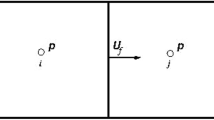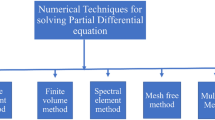Contents
The aim of this paper is to determine, by means of the finite element method, the impedance of the bar filling the semi-closed slot of an electric machine. As an example the slot of complex shape was chosen for calculations. The analysis of that case by means exact methods would have been totally impossible. An accuracy of the method has been evaluated on the basis of published data. The two-dimensional skin effect was taken into considerations.
Übersicht
Der Beitrag behandelt, mit Hilfe der Methode der finiten Elemente, die Bestimmung der Impedanzen von Leitern in der halbgeschlossenen Nut elektrischer Maschinen für den Fall kompliziert geformter Querschnitte, bei denen eine geschlossene analytische Berechnung unmöglich ist. Das Verfahren und die erreichbare Genauigkeit wird an einem Beispiel gezeigt, wobei die Stromverdrängung mit berücksichtigt wird.
Similar content being viewed by others
Abbreviations
- A :
-
z-component of vector potential (complex r.m.s. value)
- B t :
-
tangential component of induction
- I=|I| ej0 :
-
complex value of current, |I|=r.m.s. value
- \(j = \sqrt { - 1}\) :
-
imaginary unit
- |z|,z * :
-
modulus of complex numberz and complex conjugate ofz
- Re [z], Jm [z]:
-
real and imaginary part of complex numberz
- α:
-
angle of slot opening
- R o :
-
d.c. resistance
- μ:
-
magnetic permeability
- γ:
-
conductivity
- ∇2 :
-
scalar Laplacian
- ∂/∂n :
-
derivative in normal external direction
- Ω:
-
cross section area
- S :
-
boundary of area Ω
- H :
-
Hilbert's space
- H−∇2 :
-
energetic space of a positive definite ∇2
- Ωh :
-
region under triangulation
- l h :
-
boundary of Ωh
- W 12 (Ω):
-
Sobolev's space
- S h :
-
subspace ofW 12 (Ω)
- ω:
-
pulsation
References
Bahr, K.: Zur Theorie der Stromverdrängung in einer Maschinennut von rechteckigen Querschnitt. ETZ-A 86 (1965) 689–695
Bahr, K.: Die Stromverdrängung in einer Rechtecknut als Grenzfall der Stromverdrängung in einer Trapeznut. Arch. Elektrotech. 51 (1966) 52–57
Buchholz, H.: Die zweidimensionale Stromverdrängung in einer wechselstromdurchflossenen trapezförmigen Nut. Arch. Elektrotech. 49 (1965) 291–298.
Hannakam, L.; Tepe, R.: Transient skin-effect in laminated cores with sectional different material properties. Arch. Elektrotech. 1 (1979) 25–32
Laible, T.: Stromverdrängung in Nutenleitern von trapezförmigen und dreieckigen Querschnitt. Arch. Elektrotech. 27 (1937) 558–566.
Lipiński, W.: Twodimensional current displacement in the slots of electric machines. Archiwum Elektrotechniki 20 (1971) 467–478 (in Polish)
Liwschitz-Garik, M. M.: Skin effect in bars of squirrelcage rotors. Trans. AIEE 73 (1954) 255–258
Liwschitz-Garik, M. M.: Computation of skin effect in bars of squirrel-cage rotors. Trans. AIEE 74 (1955) 768 to 781
Mamak, R. S., Laithwaite, E. R.: Numerical evaluation of inductance and A.C. resistance. Trans. IEE 108C (1960) 252–258
Nedelec, J. C.: Sabrie, J. L.: Varite, J. C.: Calculation of eddy currents in a conductor and its sheath by finite element method. COMPUMAG Oxford: (1976) 316–323
Peterson, W.: Calculation of the impedance of a conductor with an elliptic cross section in the slot of an electric machine. Arch. Elektrotech. 60 (1978) 63–68
Peterson, W.: Calculation of the impedance and electromagnetic forces acting on an oval-shaped conductor in the slot of an electric machine. Arch. Elektrotech. 65 (1982) 195–201
Peterson, W.: Application of the Bubnov-Galerkin method for considering the results of skin effect in windings of electric machines. Doctoral Thesis. Polytechnic of Poznań 1980 (in Polish)
Purczyński, J.; Rolicz, P.; Sikora, R.: Use of Ritz and Bubnov-Galerkin methods for calculation of inductance and impedance of conductors. Arch. Elektrotech. 57 (1975) 119–126
Purczyński, J.; Sikora, R.: Analysis of leakage field in slots by means of separation of variables method and variation method. Rozprawy Elektrotech. 21 (1975) 475–505 (in Polish)
Policz, P.: Use of direct methods of functional analysis for calculation of non-steady electromagnetic phenomenons in electric machines and arrangements. Diss. Nr. 85 Polytechnic of Poznań, Poznań 1977 (in Polish)
Rolicz, P.: Impedance and electrodynamic force acting on a cylindrical conductor partly filling a semi-closed slot. Arch. Elektrotech. 58 (1976) (333–338)
Rolicz, P.: Transient skin effect in a rectangular conductor placed in a semi-closed slot. Arch. Elektrotech. 57 (1976) 329–338
Rolicz, P.: Transient skin effect in a cylindrical conductor placed in a semi-closed slot. Arch. Elektrotech. 58 (1976) 273–281
Rolicz, P.: Impedance of a rectangular conductor of the starting cage of a double-cage motor. Arch. Elektrotech. 63 (1981) 303–307
Rolicz, P.: Bubnov-Galerkin method for solving exterior alternating field problems. J. Phys. D.: Appl. Phys. 15 (1982) 2401–2411
Rolicz, P.: Use of the Bubnov-Galerkin method to skin effect problems for the case of unknown boundary conditions. IEEE Trans. on Magn. 18 (1982) 527–530.
Silvester, P.: AC resistance and reactance of isolated rectangular conductors. IEEE T-PAS 67 (1967) 770–774
Silvester, P.: Dynamic resistance and inductance of slotembended conductors. IEEE T-PAS 87 (1968) 250–256
Silvester, P.: The accurate calculation of skin effect in conductors of complicated shape. IEEE T-PAS 87 (1968) 735–742
Sikora, R.; Rolicz, P.: Impedance of a cylindrical conductor placed in the slot of an electric machine. Archiwum Elektrotechniki 21 (1972) 401–405 (in Polish)
Streng, G. F.; Fix, G. J.: An analysis of the finite element method. New York; Prentice-Hall 1973
Swann, S. A.; Salmon, J. W.: Effective resistance and reactance of a solid cylindrical conductor placed in a semi-closed slot. Proc. IEE 190 C (1962) 611–615
Swann, S. A.: Salmon, I. W.: Effective resistance and reactance of a rectangular conductor placed in a semiclosed slot. Proc. IEE 110 (1963) 1656–1660
Tuschak, R.: Stroverdrängung von in kreisförmigen Nuten gebetteten massiven Leitern. Periodica Polytechnica Electr. Eng. 1 (1957) 27–51
Verma, S. P.: Abo-Shady, S. E.: Calculation of transient skin effect in conductors embended in slots. COMPUMAG Oxford (1976) 407–416
Author information
Authors and Affiliations
Rights and permissions
About this article
Cite this article
Peterson, W. The finite element method application to the slot impedance calculation. Archiv f. Elektrotechnik 67, 203–209 (1984). https://doi.org/10.1007/BF01584525
Received:
Issue Date:
DOI: https://doi.org/10.1007/BF01584525




